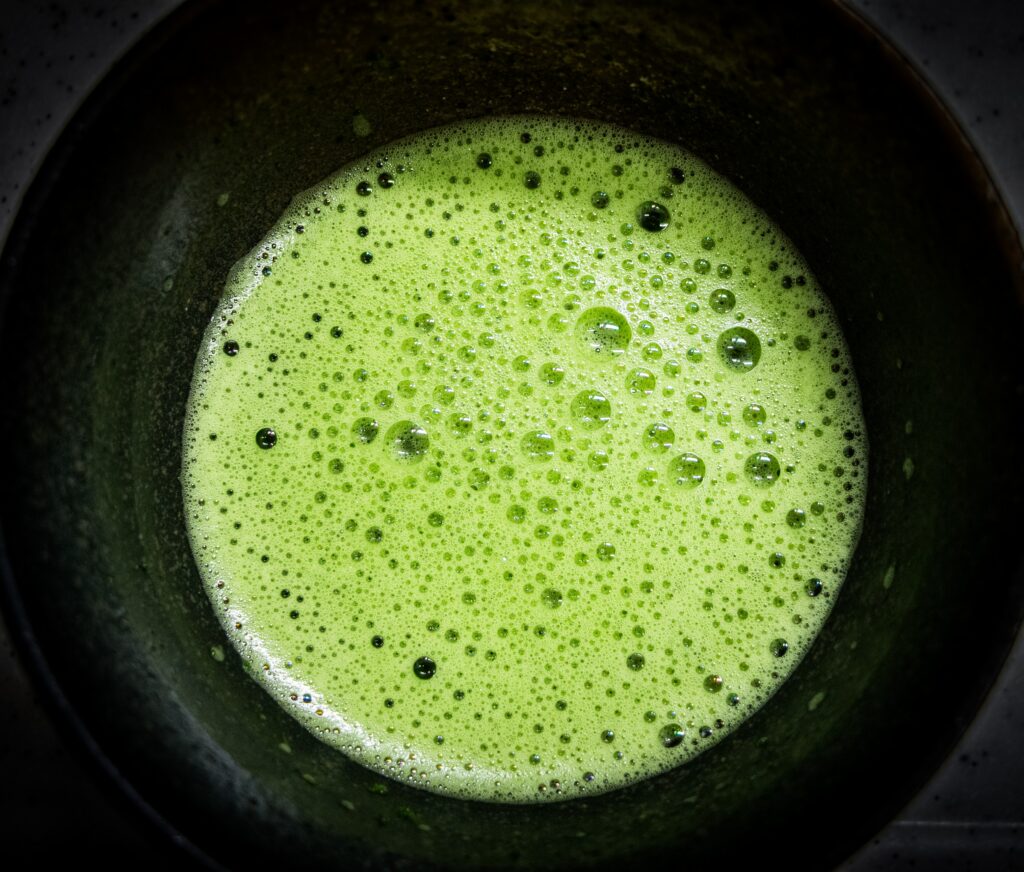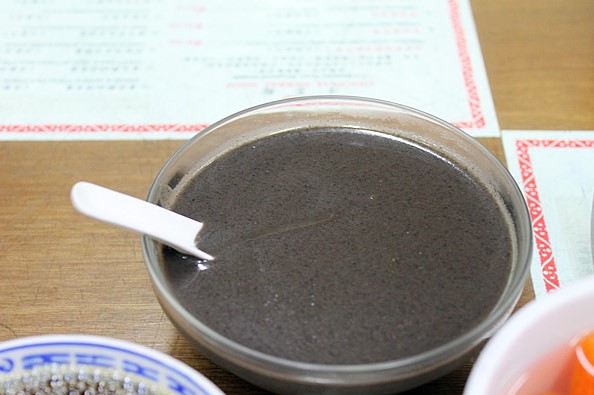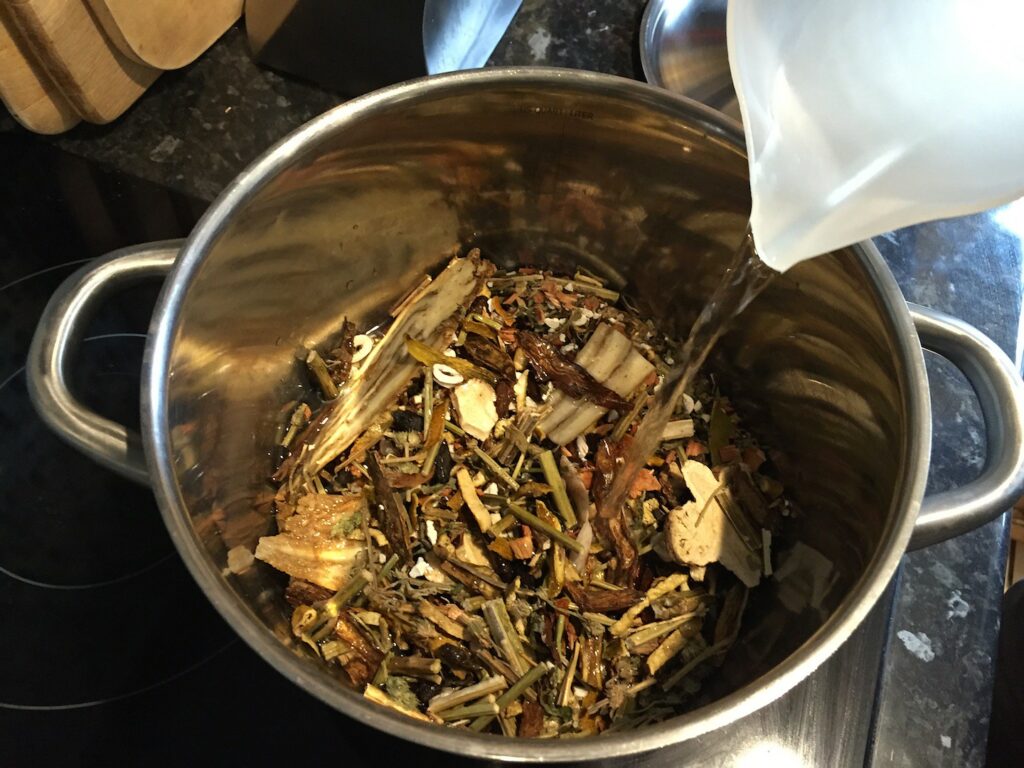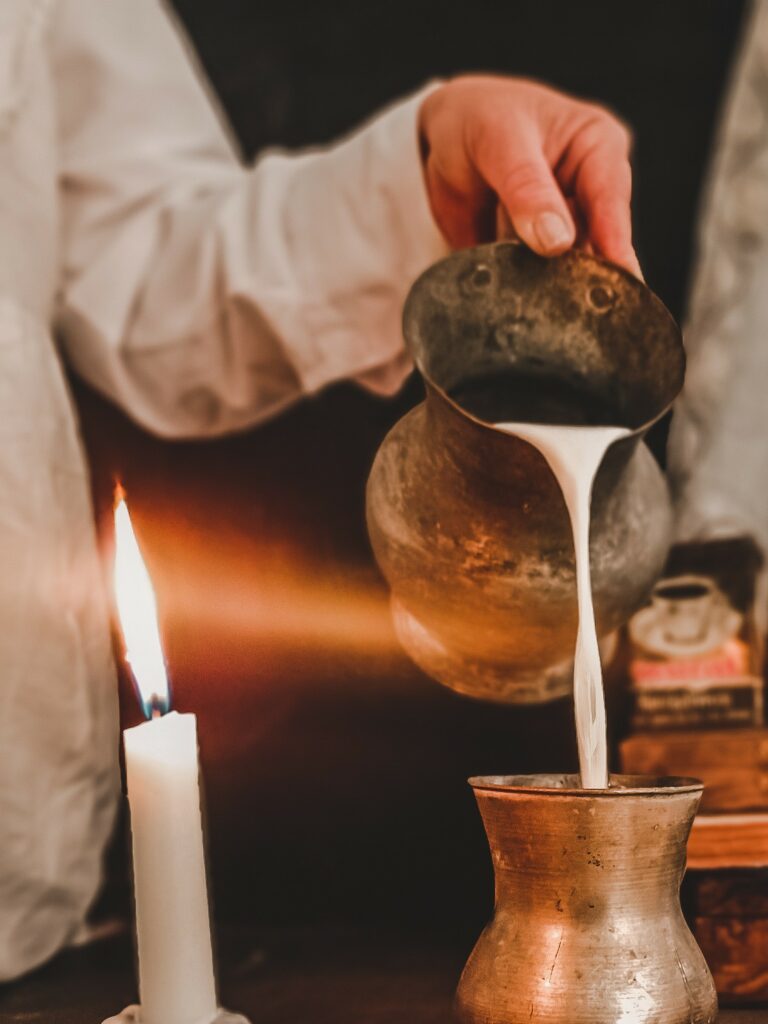The Pancha kashaya
Herbal medicine are generally prepared according to five basic methods of extraction: the fresh juice of the plant (svarasa); the crushed pulp or paste of the plant (kalka); decoction (kvatha); hot infusion (yhant); and cold infusion (hima). Juice is the strongest; cold infusion the weakest. The rest fall into a descending order of strength.
Fresh Juice (Svarasa)

The fresh juice of an herb is obtained by taking the fresh plant, crushing or pounding it, then straining the liquid through a cloth.
A juicer may also be used for this purpose. This method is not used that often because it relies mainly on freshly picked herbs. Easily available herbs–aloe vera, ginger, lemon, lime, onions, parsley … are also used in the above process, but the effects are best for wild or home grown herbs.
For dry herbs, a weaker juice preparation is made by taking the crushed dry herb or powder, adding twice the weight of the herb in water, allowing to set for 24 hours, and then straining the liquid for a juice substitution.
Herbal Paste (Kalka)

The paste of an herb is obtained by crushing the fresh plant but only to the point where it becomes a soft mass. It can be done with dried herbs, with the addition of enough water to create a workable paste.
Such pastes can be made with honey, ghee or oil, usually in double the amount of the herbs. Various raw sugars can also be used in equal amounts to the herbs. Liquid substances work better with dry herbs, dry substances with fresh herbs.
This mode of preparation is often used externally for plasters and poultices to promote the healing of wounds and sores. (Please see section on Herbs for External Usage.) It may also be used as a basis for infusions and decoctions, an herbal paste being prepared first and then cooked. All herbs can be used in this manner.
Decoction (Kvatha)

Herbs are usually administered in the form of a decoction or a hot infusion. The difference is that a decoction involves boiling the herbs over a low flame. A hot infusion involves cooking them below the boiling point, or steeping them, bringing them to a boil and then removing them from the heat.
The general rule for decoctions: one part dry herbs to six teen parts water; about half an ounce of herbs per cup or 8 ounces of water. Herbs are then boiled over a low flame until the water is reduced to one quarter of its original amount (for example, four cups would be boiled down to one); the herbs are then strained and the liquid is used as a prepared decoction. This process takes several hours or more and produces a stronger decoction than that usually used in western herbalism.
A moderate decoction, requiring less time, can be made by boiling the herbs until half the water is left. A weak decoction takes even less time to prepare since three-quarters of the water is left. The lesser strength of these preparations can be balanced by taking or giving larger dosages.
The resultant strong tea is then administered usually with otiher vehicles like honey or hot water (see section on anupanas and section on dosages).
In Ayurveda the herbs are only boiled once and then discarded. Some herbalists of other traditions boil them two or three times. This is possible, particularly when the first decoction is of weak or moderate strength.
The decoction method is most suitable for roots, stems, bark and fruit as harder portions of the plant require longer cooking to release their essence.
Hot Infusion (Phant)
For infusions the ratio of herbs to water is one to eight. For example, one ounce herbs per eight ounce cup of water. In the hot infusion, the herbs are added to boiling water and allowed to set for a period of up to twelve hours. This again is longer than the required time used in western herbalism. Usually thirty minutes of steeping is the minimum required for an infusion.
The herbs are then strained and the liquid used. Infusion is better for more delicate plant parts; leaves and flowers, or more herbaceous (non-woody) plants. It is also better for aromatic herbs, like most spices, because boiling destroys and dissipates the aromatic oil. However, many of these herbs can be cooked below the boiling point over a low flame for a long period of time. This may be necessary in formulas that combine root herbs with flowers or leaves; otherwise the more delicate herbs can beadded at a later stage of the decoction.
Cold Infusion (Hima)
Cold infusion requires letting the herbs stand in cold water. Usually more time is required for this than for a hot infusion–at least an hour.
It is also best to let the herbs stand overnight. This method is necessary for delicate and aromatic herbs, particularly those with cooling energy or refrigerant properties. Cold infusion is best for cooling therapy and reducing high Pitta conditions.
Such herbs as hibiscus, jasmine, mint and sandalwood are prepared in this manner. The infusion method is usually best for powders, as they release their properties more quickly than raw herbs. Cold infusion is better for anti-Pitta action; otherwise hot infusion is usually best.
Additionnal methods of herbals
Milk Decoctions

Decoctions can be done with milk as well as water. The classical method was to take one part herbs, eight parts of milk and thirty-two parts water. The mixture was boiled over a low flame until all the water evaporated. For example, one ounce of herbs was used with one cup of milk and four cups of water.
However, it is also true that smaller amounts of water can be used with certain herbs cooked directly in the milk. This simpler, direct milk decoction can be done with powders.
Milk augments the tonic and nutritive effects of herbs, like ashwagandha or shatavari. It possesses demulcent properties and combines well with herbs (e.g. comfrey root or slippery elm), for soothing the mucous membranes.
With cooling effects, it helps to stop bleeding and reduces inflammation. It can also help to harmonize or work as an antidote in the presence of hot, pungent herbs. Milk may be used as a sedative and it can be combined with certain herbs like gotu kola or nutmeg to promote sleep.
Vessels to Use
According to Ayurveda, the best kind of vessel or pot to use for herbal preparations is an earthen pot. Earthenware combines naturally with herbs the same way plants are intrinsically a part of the soil.
Ayurveda is not, however, opposed to the use of certain metallic vessels, if their properties are understood.
To reduce Kapha, herbs can be prepared in a copper pot because copper has a scraping and reducing action. For Pitta conditions, a pot of brass or silver may be used; these metals are cooling. For Vata, iron may be used as it is heavy and grounding. Aluminum should never be used because it will be absorbed in the body as a poison.
Preparing the herbs over a flame, rather than electrical heat, also helps increase their potency and renders them more assimilable to our Agni; wood heat is best.
References
The Significance of Ayurvedic Medicinal Plants
https://www.ncbi.nlm.nih.gov/pmc/articles/PMC4296439/
https://www.medicalnewstoday.com/articles/ayurvedic-herbs#ashwagandha
https://www.nhp.gov.in/introduction-and-importance-of-medicinal-plants-and-herbs_mtl
https://www.omicsonline.org/open-access/ayurvedic-plants-in-brain-disorders-the-herbal-hope.php?aid=89160
